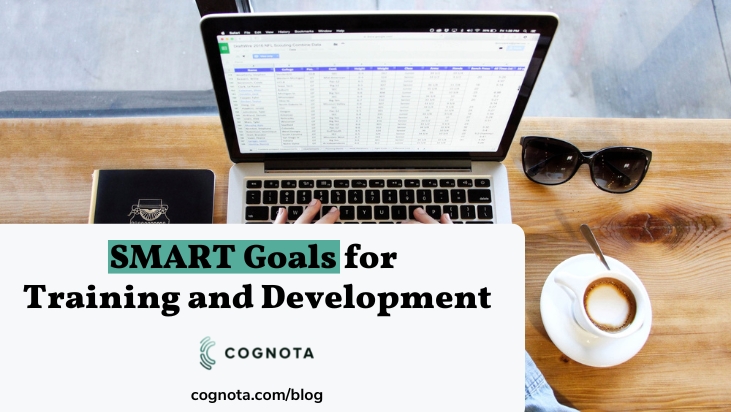Setting goals for yourself and your team is one of the most important steps to establishing a successful training and development program. However, setting goals that are realistic enough to be reachable but challenging enough to encourage all team members to grow and excel, is not easy.
To establish helpful goals, your L&D team will need solid input regarding corporate priorities and KPIs as well as an accurate understanding of the strengths and gaps in your team’s knowledge and skills.
Assuming that you have the information you need, how can you establish goals that anchor your activities and provide a framework for evaluating the effectiveness of all your learning and development efforts?
It’s a matter of being SMART with your L&D goals. An acronym that stands for: Specific, Measurable, Achievable, Relevant, and Timely, SMART goals provide L&D teams with a framework that allows them to evaluate the success of their training efforts. They can accurately assess what worked well, what needs to be bolstered, and what should be tabled–or possibly scrapped altogether.
What are SMART goals?
It’s one thing to say confidently that SMART goals are Specific, Measurable, Achievable, Relevant, and Timely, but what does that mean, exactly? Here’s how to unpack each of these characteristics:
Specific: A specific goal clearly and concisely addresses what needs to be done and by whom. For example:
- What do we need to accomplish?
- Who has ultimate responsibility for making sure things get done?
- Will the goal be accomplished in phases?
- If so, who is responsible for the accomplishment of each phase?
Specific goals make it easy to understand what the desired result is and which individuals play key roles in accomplishing that result. For instance, a specific goal might be: “Prepare new sales reps to succeed by implementing a mandatory–but flexible–training module that includes scripts, details about our product/service, and answers to FAQs.”
Measurable: Perhaps you remember childhood road trips when you asked repeatedly, “Are we there yet?” Your parent, or whoever was driving, knew the answer because he or she knew where you were going.
Measurable goals allow you to answer the “Are we there yet?” question when you’re queried by interested stakeholders who want to know if your organization is performing well.
Because they are quantifiable, measurable goals reveal whether or not the benchmark was met. Say, for example, you want to “increase sales by 10%,” “boost average employee retention by 15%,” or “decrease customer churn by 2%.” As long as you monitor and record results, you will know if you met your goal.
Goals that aren’t measurable don’t afford you the opportunity to be decisive. At best, you can hope or guess or assume that you did–or didn’t–reach your goal, but you can’t be certain. You can’t be sure “you’re there yet.”
There’s no doubt that measurement is top of mind for L&D teams. In a 2022 survey from LEO Learning and Watershed, 50% of respondents said they felt pressure from executive teams to measure learning’s business impact.
Achievable: Achievable goals are realistic. They are within the realm of possibility, given the physical and human resources available to your company.
Writing achievable goals might be the most difficult part of the planning process, because you have to put aside “pie in the sky,” perfect-world aspirations and seriously evaluate the talent and physical resources available right now. You may want to “increase customer service feedback scores by 25% in the next 3 months,” but labor shortages may have caused your employee turnover in sales to soar.
Before you set a goal that may cause frustration and more turnover, consider the feasibility of increasing customer feedback scores by 25% in only 3 months, especially if you’re constantly training new salespeople.
Relevant: Relevant goals matter, because they align with your company’s overall strategy. Stakeholders care that you meet these goals, since they contribute to the overall mission of the company, while also contributing to ROI and other key metrics.
It can be useful to grade your SMART goals according to how closely they align with high-impact or high-priority business objectives, for example.
Timely: Timely (or time-bound) goals are anchored within a timeframe. Adding a time limit to the measurable goals mentioned earlier increases their SMARTness and provides one more dimension to measure.
These goals now become, “increase sales by 10% within 6 months,” “boost average employee retention by 15% over the next fiscal year,” or “decrease customer churn by 2% next quarter.”
How can SMART goals be used in training and development?
Setting learning objectives and training goals
In the context of training and development, SMART goals refer to objectives that are carefully defined and designed to enhance employee knowledge, performance and skills. For example:
- Specific: “Improve customer service skills by 20% in 6 months.” Or, “Decrease on-the-job injury rate by 25% in the next 3 months.”
- Measurable: “Participate in a customer service workshop and pass the exam with a score of 80% or higher.” Or, “Attend a workplace safety seminar and complete all the training modules.”
- Achievable: “Receive feedback from supervisors and peers, and complete at least 2 customer service role-playing exercises per week.”
- Relevant: “Reducing work-related injuries by 25% will increase employee morale, reduce medical and insurance costs, and improve ROI.”
- Time-bound: “Decreasing the workplace injury rate by 25% in the next 3 months will also decrease the number of work days missed and increase our overall production volume for the year.”
Creating and tracking departmental objectives for L&D
In addition to ensuring that training teams throughout the company understand, create and implement SMART goals, L&D teams must also plan and carry out their own goals. Here are some examples of how SMART goals can be applied internally for L&D teams in a learning operations context:
- Aligning all training initiatives to business objectives. Corporate goals must drive any training programs; high-priority goals or goals associated with the company’s brand image need to receive top priority in L&D’s planning and budget.
- Understanding how to prioritize and schedule training initiatives. This correlates with aligning training initiatives, so they meet business objectives. But, it also considers the needs of your learners. What training requests do they make? Does customer feedback indicate that your training programs need a strong focus on customer service? Product knowledge? Something else? The more you understand corporate objectives and learner needs, the greater impact your training programs are likely to have.
- Using time-bound goals to ensure that resources are never stretched too thin. The time aspect of SMART goals is critical, especially for budgeting of human and monetary resources. Is a training initiative successful if it reaches the desired goal, but takes 6 months instead of 3, and runs over budget by 26%? Well, yes–and no–depending upon your perspective. If you are the team leader responsible to make sure your team meets the goal, you would likely say you met it. But, from an L&D perspective, successfully meeting this goal may mean you lack time and money to accomplish another key initiative.
- Measuring the effectiveness of the L&D team, and its impact on business objectives. Historically, L&D efforts were only loosely linked to objective measurement tools. The success of L&D programs was evaluated subjectively by getting participant feedback about the instructor, the content, and the timing, enjoyability, or length of the program. Today, however, increasing numbers of companies use data analytics to evaluate L&D objectively. They expect the L&D department to verify that it contributed to the bottom line just as other departments do.
- Verifying that goals are achievable before they are approved. Anyone involved in the goal-setting process is familiar with the temptation to establish goals that could be reached only if everything went exactly right, and every contingency worked to the planner’s advantage. Unfortunately, real life’s messy. Goals that consistently rely upon the best-case scenario are rarely achievable.
Examples of setting SMART goals for training and development
Setting SMART goals for training and development can help ensure that your team achieves its objectives. Beyond committing to making sure the goals are actually SMART (specific, measurable, achievable, relevant, and time-bound,) how can you ensure that you and your L&D team actually follow through? Here are a few tips to keep in mind:
1. Clearly communicate the top priorities for training and development. These will certainly align with the overall strategy of the organization. Beyond that, you’ll need to address why they matter for your team and for each person in your company.
In a recent survey by Remote.co, almost two-thirds (63%) of the global workers who responded said they would “absolutely” look for a new job if they couldn’t continue to work remotely. Professionals who answered the survey listed “remote work options” as the most important factor in their job satisfaction.
Given the importance that employees now place on remote work options, training initiatives geared to remote workers is quite possibly a major corporate objective. If so, a learning and development goal of “increasing training resources for remote workers by 50% in the next 6 months” would support corporate objectives. It would also meet the need of a growing number of workers, and help you retain valuable talent.
2. Involve your team from the very beginning of the process. Use the goal-setting process as a team-strengthening L&D activity. Give everyone an opportunity to make suggestions. Solicit viewpoints from team members who are less vocal. Listen to their ideas.
Honest discussions like this spotlight problems and generate ideas. They also build team rapport, which–according to a survey by Asana–fosters mutual trust, team loyalty and group engagement.
3. Be willing to be transparent. Setting SMART goals requires accurate information about past performance as well as realistic projections for the future. For instance, suppose that one of your priorities for the next year is to overhaul and streamline your training intake process. Your team will understand the necessity of doing so if you explain that 40% of last year’s training initiatives were driven by on-the-spot requests by executives who requested “a seminar to fix this problem,” rather than by team members or managers who understand the root issue causing the problem.
Supplement those details with cost/benefit numbers that validate which training programs achieved desired results and which ones acted only as a temporary solution.
4. Cultivate a learning culture–in your team, first–and then model that culture throughout your organization. Give learning team members the opportunity to enhance their knowledge and advance their leadership skills. Encourage them to get out of their comfort zones. Help them master the technology that enables them to better serve their learners.
5. Measure your results as you go. Monitor your progress as you move through the planning period. Then, measure your effectiveness. For example, is your project completion rate on target? Is the student satisfaction rate meeting your goal? Are you contributing to ROI as expected? You can’t know if you’re reaching your goals if you don’t measure the results.
6. Be prepared to adjust your goals as needed based on feedback and results achieved. Adjusting goals in the middle of a year or other planning period used to be tedious. Now, thanks to technological advances, adapting is easy, as long as you have robust software that is adaptive and agile.
Get the data you need to define and track SMART goals for your training team
SMART goals are a proven way to effectively plan and execute training and development.
By setting specific, measurable, attainable, results-oriented and time-bound objectives, you will know where you’re heading and be able to track your progress.
Cognota’s LearnOps software enables you and your L&D team to plan, manage and execute training initiatives and daily workflows in one place. You’ll get shareable data on your team’s operations to support the setting and tracking of SMART goals and demonstrate L&D’s impact. Get started for free or speak with sales to learn more.







